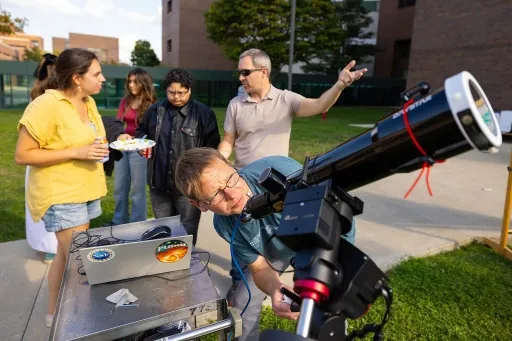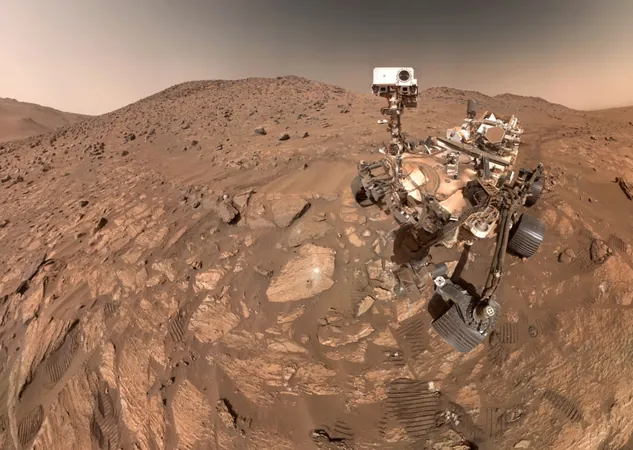
Unlock the Secrets of the Sun: A Unique Solar Telescope Experience
2025-09-22
Author: Olivia
Experience the Power of the Sun Up Close!
Katelyn Eaman, a geology graduate student, understands the sun's incredible impact on our solar system better than most. Her research delves into how Mars was once sculpted by flowing water—until its magnetic field vanished, leading to the loss of its atmosphere and liquid water.
A Stellar Opportunity to Stargaze
Recently, Eaman got a rare chance to observe our closest star through a groundbreaking solar telescope at the Department of Earth Sciences’ welcome picnic. "I’m grateful that our department provides such amazing resources for everyone," Eaman shared. This innovative telescope is set for frequent use, with plans for student and community events to explore its capabilities.
From Eclipse to Education: The Journey of a Solar Telescope
This same telescope was instrumental during last year’s total solar eclipse at Lake Erie State Park, under the guidance of Professor Beata Csatho. Leading one of 35 teams in the Citizen Continental-America Telescope Eclipse (CATE) project—backed by NASA and the National Science Foundation—Csatho captured stunning polarized images of the Sun’s corona, an elusive sight only visible during an eclipse.
"After the eclipse, NASA gifted us the telescope on the condition we use it for educational outreach, and that’s precisely our mission now," Csatho explained enthusiastically. She looks forward to incorporating it into her teaching while engaging the community with fascinating astronomical phenomena.
High-Tech Insights into Solar Dynamics
Unlike traditional telescopes made for distant stars, solar telescopes are finely tuned to handle the intense brightness of the sun. Equipped with a detachable filter that dramatically reduces brightness, observers can safely gaze at the sun without risking eye damage or harming the telescope's optics. The telescope provides a digital view displayed on a laptop, capturing high-quality images while analyzing the sun’s light in various wavelengths.
Real-Time Tracking and Ongoing Research
With advanced computer technology, the telescope can autonomously adjust its position to keep the sun centered—a feature that Nicholas DiFrancesco, an assistant teaching professor, finds invaluable. "The computer compensates for Earth’s rotation, ensuring we can maintain focus on the sun during our observations," he noted.
Solar Maximum: A Time of Cosmic Activity
Currently, we are experiencing a solar maximum—the peak of the sun's 11-year magnetic cycle when solar activity is at its zenith. This period can generate breathtaking auroras while also posing risks to satellites and communication systems.
DiFrancesco emphasized the importance of making solar phenomena tangible for students. "Understanding the sun's influence on Earth and the solar system is crucial, and this telescope brings that reality to life." Csatho echoed this sentiment, expressing excitement about the hands-on learning experience the telescope provides.
A Window into Our Solar System
By allowing students and the community to engage with such advanced equipment, the telescope serves as a gateway to seeing the solar system like never before. "It’s rewarding for students to touch and interact with equipment that offers real images of the cosmos," Csatho remarked. This unique initiative promises to illuminate the wonders of our sun and beyond!









 Brasil (PT)
Brasil (PT)
 Canada (EN)
Canada (EN)
 Chile (ES)
Chile (ES)
 Česko (CS)
Česko (CS)
 대한민국 (KO)
대한민국 (KO)
 España (ES)
España (ES)
 France (FR)
France (FR)
 Hong Kong (EN)
Hong Kong (EN)
 Italia (IT)
Italia (IT)
 日本 (JA)
日本 (JA)
 Magyarország (HU)
Magyarország (HU)
 Norge (NO)
Norge (NO)
 Polska (PL)
Polska (PL)
 Schweiz (DE)
Schweiz (DE)
 Singapore (EN)
Singapore (EN)
 Sverige (SV)
Sverige (SV)
 Suomi (FI)
Suomi (FI)
 Türkiye (TR)
Türkiye (TR)
 الإمارات العربية المتحدة (AR)
الإمارات العربية المتحدة (AR)